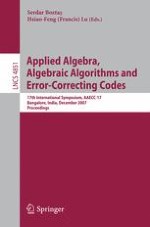2007 | Buch
Applied Algebra, Algebraic Algorithms and Error-Correcting Codes
17th International Symposium, AAECC-17, Bangalore, India, December 16-20, 2007. Proceedings
herausgegeben von: Serdar Boztaş, Hsiao-Feng (Francis) Lu
Verlag: Springer Berlin Heidelberg
Buchreihe : Lecture Notes in Computer Science
